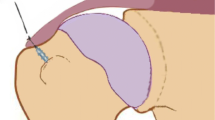Abstract
Introduction
Rotator cuff injury is one of the most frequently encountered problems of the shoulder in the daily practice of orthopaedic surgeons. This study compared all-arthroscopic cuff repair (ARCR) and mini-open rotator cuff repair (MORCR) methods in regard to clinical outcomes and costs.
Methods
Fifty patient charts and operative repairs were analysed (25 ARCR and 25 MORCR). Pre-and postoperative Constant-Murley and UCLA scores along with factors such as tear size, tear type, pre-operative physical therapy, motion and satisfaction levels were compared for the two procedures. Cost-benefit analysis was also performed for comparison between procedures. The duration of follow-up was 31.20 and 21.56 months for MORCR and ARCR groups, respectively.
Results
Tear sizes (P=0.68), pre-and postoperative Constant-Murley and UCLA scores (P=0.254) and satisfaction levels were not significantly different between groups. However, the differences between pre-and postoperative Constant-Murley and UCLA scores were statistically significant within both groups (P<0.01). The MORCR group stayed 1 day longer in hospital than the ARCR group, which was statistically significant (P=0.036). The differences regarding mean pain scores, abductions, internal and external rotations in Constant-Murley scores and forward flexion scores in UCLA scores were not significant. The ARCR group cost more, leaving less profit.
Conclusion
Results suggest that ARCR yields similar clinical results but at a higher cost compared with MORCR.
Similar content being viewed by others

References
Codman EA. Rupture of the supraspinatus tendon. 1911. Clin Orthop Relat Res. 1990;(254):3-26.
Ellman H, Kay SP, Wirth M. Arthroscopic treatment of full-thickness rotator cuff tears: 2-to 7-year follow-up study. Arthroscopy. 1993;9:195–200.
Tauro JC. Arthroscopic rotator cuff repair: analysis of technique and results at 2-and 3-year follow-up. Arthroscopy. 1998;14:45–51.
Weber SC. Arthroscopic debridement and acromioplasty versus mini-open repair in the management of significant partialthickness tears of the rotator cuff. Orthop Clin North Am. 1997;28:79–82.
Constant CR, Murley AH. A clinical method of functional assessment of the shoulder. Clin Orthop Relat Res. 1987;(214):160–164.
Amstutz HC, Sew Hoy AL, Clarke IC. UCLA anatomic total shoulder arthroplasty. Clin Orthop Relat Res. 1981;(155):7–20.
Demirhan M, Atalar AC, Kocabey Y, Akalin Y. Arthroscopic-assisted mini-open rotator cuff repair [in Turkish]. Acta Orthop Traumatol Turc. 2002;36:1–6.
Ellman H, Hanker G, Bayer M. Repair of the rotator cuff. End-result study of factors influencing reconstruction. J Bone Joint Surg Am. 1986;68:1136–1144.
Iannotti JP. Full-thickness rotator cuff tears: factors affecting surgical outcome. J Am Acad Orthop Surg. 1994;2:87–95.
Gartsman GM, Khan M, Hammerman SM. Arthroscopic repair of full-thickness tears of the rotator cuff. J Bone Joint Surg Am. 1998;80:832–840.
Liu SH, Baker CL. Arthroscopically assisted rotator cuff repair: correlation of functional results with integrity of the cuff. Arthroscopy. 1994;10:54–60.
Warner JJ, Goitz RJ, Irrgang JJ, Groff YJ. Arthroscopic-assisted rotator cuff repair: patient selection and treatment outcome. J Shoulder Elbow Surg. 1997;6:463–472.
Weber SC, Schaefer R. “Mini open” versus traditional open repair in the management of small and moderate size tears of the rotator cuff. Arthroscopy. 1993;9:365–366.
Norberg FB, Field LD, Savoie FH 3rd. Repair of the rotator cuff. Mini-open and arthroscopic repairs. Clin Sports Med. 2000;19:77–99.
Severud EL, Ruotolo C, Abbott DD, Nottage WM. All-arthroscopic versus mini-open rotator cuff repair: a longterm retrospective outcome comparison. Arthroscopy. 2003;19:234–238.
Verma NN, Dunn W, Adler RS, et al. All-arthroscopic versus mini-open rotator cuff repair: a retrospective review with minimum 2-year follow-up. Arthroscopy. 2006;22:587–594.
Youm T, Murray DH, Kubiak EN, Rokito AS, Zuckerman JD. Arthroscopic versus mini-open rotator cuff repair: a comparison of clinical outcomes and patient satisfaction. J Shoulder Elbow Surg. 2005;14:455–459.
Hersch JC, Sgaglione NA. Arthroscopically assisted mini-open rotator cuff repairs. Functional outcome at 2-to 7-year follow-up. Am J Sports Med. 2000;28:301–311.
Cofield RH, Parvizi J, Hoffmeyer PJ, Lanzer WL, Ilstrup DM, Rowland CM. Surgical repair of chronic rotator cuff tears. A prospective long-term study. J Bone Joint Surg Am. 2001;83-A:71–77.
Gazielly DF, Gleyze P, Montagnon C. Functional and anatomical results after rotator cuff repair. Clin Orthop Relat Res. 1994;(304):43–53.
Matthews TJ, Hand GC, Rees JL, Athanasou NA, Carr AJ. Pathology of the torn rotator cuff tendon. Reduction in potential for repair as tear size increases. J Bone Joint Surg Br. 2006;88:489–495.
McCabe RA, Nicholas SJ, Montgomery KD, Finneran JJ, McHugh MP. The effect of rotator cuff tear size on shoulder strength and range of motion. J Orthop Sports Phys Ther. 2005;35:130–135.
Motycka T, Kriegleder B, Landsiedl F. Results of open repair of the rotator cuff-a long-term review of 79 shoulders. Arch Orthop Trauma Surg. 2001;121:148–151.
Romeo AA, Hang DW, Bach BR Jr, Shott S. Repair of full thickness rotator cuff tears. Gender, age, and other factors affecting outcome. Clin Orthop Relat Res. 1999;(367):243–255.
Hata Y, Saitoh S, Murakami N, Seki H, Nakatsuchi Y, Takaoka K. A less invasive surgery for rotator cuff tear: mini-open repair. J Shoulder Elbow Surg. 2001;10:11–16.
Author information
Authors and Affiliations
Corresponding author
Rights and permissions
About this article
Cite this article
Köse, K.Ç., Tezen, E., Cebesoy, O. et al. Mini-open versus all-arthroscopic rotator cuff repair: Comparison of the operative costs and the clinical outcomes. Adv Therapy 25, 249–259 (2008). https://doi.org/10.1007/s12325-008-0031-0
Published:
Issue Date:
DOI: https://doi.org/10.1007/s12325-008-0031-0



